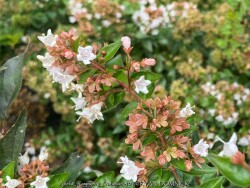

Raspberry Profusion Abelia (Abelia chinensis 'Raspberry Profusion') is a compact rounded, spreading, multi-stemmed shrub in the honeysuckle family. Typically grows on gracefully arching branches to 2-4' tall. 'Raspberry Profusion', a seedling selection of 'Edward Goucher' x chinensis, blooms heavily from May to September. The entire plant is covered with big clusters of strongly-scented, pink flowers with flamboyant raspberry sepals. The sepals remain after the flowers drop, extending the color until the end of autumn. New growth emerges glossy red and ages to a handsome dark green. The shrub is robust and compact, growing to 3-4' tall and wide. It is mostly deciduous in the winter. Semi-evergreen dark green leaves turn purplish-bronze in autumn persisting until 10 degrees F or so. Wood is hardy to 0 degrees F. In years where the stems die to the ground in winter but the plant survives, flowering will still occur on new growth. 'Raspberry Profusion' Abelia (Abelia chinensis 'Raspberry Profusion') is an unusually hardy abelia, thriving even in zone 5b. Abelia is also known for it's fragrant flowers that attract butterflies and hummingbirds, plus it's shade-tolerant and resistant to both deer and rabbits. Graceful, arching habit makes it a perfect choice for late season fragrance in your landscape.


***Description comming later*** from Heritage Nursery "A fine cultivar distinguished by its bright red foliage. Whereas the more widely available cultivar, 'Bloodgood' has a maroon color, this one is redder, especially when the sun shines through the leaves. Leaves emerge two weeks later than 'Bloodgood'. Milwaukee, WI city arborists consider 'Emperor I' hardy within their urban area."


Oshio Beni Japanese maple (Acer palmatum 'Oshio Beni') is a small tree with gracefully branched stems and palmate red-purple leaves that turn bright red in the fall. Oshio Beni has improved purplish maroon summer foliage color and bright red-orange new growth in teh spring. Used in Kansas landscapes small lawn tree or understory tree in full to part shade needing rich, moist soils. Even with ideal growing conditions, growth is slow. Avoid afternoon sun in the heat of summer as leaf tips will burn. I have seen tremendous late spring freeze damage on rare occasions.
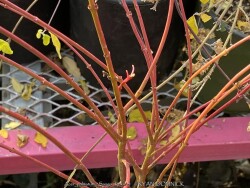

Sango Kaku Coral-twig Japanese Maple (Acer palmatum 'Sango Kaku') is a small tree with gracefully branched stems and palmate reddish-green leaves that turn bright red in the fall. Sango Kaku has amazing winter twig color that is a bright coral-red-orange color. Used in Kansas landscapes small lawn tree or understory tree in full to part shade needing rich, moist soils. Even with ideal growing conditions, growth is slow. Avoid afternoon sun in the heat of summer as leaf tips will burn. I have seen tremendous late spring freeze damage on rare occasions so cover if growth has started if the forcast calls for 28 degrees F or lower.


***Description comming later*** from Heritage Nursery "This beautiful gem is more strongly weeping than most other selections of its kind. It goes through a kaleidoscope of reds, greens, and orange all season long."


***Description comming later*** from Heritage Nursery "Among the best of the weeping red laceleaf maples, known for its leaf color retention in summer, its scorch resistance, vigor, and hardiness. Always popular and attractive."


***Description comming later*** from Heritage Nursery "Among the best of the weeping red laceleaf maples, known for its leaf color retention in summer, its scorch resistance, vigor, and hardiness. Always popular and attractive."
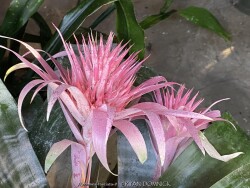

Silver Vase / Urn Plant (Aechmea fasciata) is an exotic-looking flowering plant from the bromeliad (Bromeliaceae) family. Despite its exotic appearance and tropical nature, this bromeliad adapts well to living as a potted house plant. In Kansas, use as a summer patio plant and protect from direct sunlight in mid summer and any temperatures below 50 degrees F in the spring or fall. As an epiphyte, much of its water needs are met by keeping the plants center "Urn" filled with water once per week or two. They have a shallow root systems and probably won't ever need repotted. When flowering, the flowers themselves are short-lived, but the pink and red bracts last for a few months.


Millenium Ornamental Onion (Allium 'Millenium') is among the best of the ornamental onions. This award-winning perennial produces a compact clump of glossy green leaves. Bright rosy purple, rounded flower clusters appear on strong stems just above the foliage. Unlike spring-blooming Allium bulbs, 'Millenium' blooms in mid-summer. The attractive, shiny deep-green grassy foliage is very ornamental and lasts all season including winter interest in Kansas. Grow in just about any soil including heavy clay in full to part sun. In Eastern Kansas, typically our 40 inches of rainfall is sufficient without extra water. And as with all alliums, these are completely rabbit proof. Considered a "Once it's there, it's there forever" plant!


Serendipity Ornamental Onion (Allium 'Serendipity') is among the best of the ornamental onions. This award-winning perennial produces a compact clump of glossy blu-green leaves. Bright rosy purple, rounded flower clusters appear on strong stems just above the foliage. Unlike spring-blooming Allium bulbs, 'Serendipity' blooms in mid-summer. The attractive, shiny deep-green grassy foliage is very ornamental and lasts all season including winter interest in Kansas. Grow in just about any soil including heavy clay in full to part sun. In Eastern Kansas, typically our 40 inches of rainfall is sufficient without extra water. And as with all alliums, these are completely rabbit proof. Considered a "Once it's there, it's there forever" plant!


***Description for this hardy tropical available with future update!*** >>>>> Plant delights nursery says "Alstroemeria 'Golden Tiara' is a 2022 Plant Delights/JLBG introduction of a gold-flowered sport of Alstroemeria 'Koice' (Inca Ice) that we found here. We sent plants to Michigan's Walters Gardens for testing, where it has thrived in their Zone 5b field trials. Alstroemeria 'Golden Tiara' forms a 5' wide, dense patch of upright stalks, which begin flowering in early June and continues well into fall, slowing somewhat in the heat of midsummer. The first round of stalks are 2' tall, but the stalks produced later in the summer and fall, top out at 45" tall. The flowers are bright golden yellow with an orange exterior throat. This is a stunning color addition to the line of very hardy princess lilies."


***Description for this hardy tropical available with future update!*** >>>>> Plant delights nursery says "Alstroemeria 'Indian Summer' is a breeding breakthrough in garden quality alstroemerias. This amazing selection has sailed through both our trials for heat and humidity as well as winter hardiness trials in western Michigan (multiple winters of below -15 degrees F). Alstroemeria 'Indian Summer' emerges in spring with 3' tall purple-tinted stalks, clothed with grey purple foliage, and topped, starting in late spring, with terminal clusters of flowers. The flowers are composed of three orange petals, intermixed with three yellow petals with violet flecks. Flowering slows in the heat or summer, but resumes as night temperatures cool, and continues until frost. The effect of Alstroemeria 'Indian Summer' in the garden is truly stunning!"
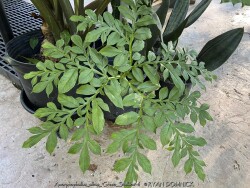

***Description for this hardy tropical available with future update!***>>>>> Plant Delights Nursery says "This little-known but easy-to-grow voodoo lily is native to the Yunnan Province of China. The stalks are either solid green or green with grey spots and are each topped with a glossy green leaf. Amorphophallus albus is a fast offsetting species that forms a nice 2' wide patch (in 5 years) in the woodland garden. In spring, just as the leaf emerges, a 1' tall flower stalk appears alongside it with a 6-8" tall flower perched on top. Each flower resembles a large ivory shell showcasing a white, cigar-like appendage...green at the tip and white at the base." >>>>>>>>>> Voodoo (Amorphophallus konjac) lily is a perennial tuber generally grown as a curiosity for its interesting foliage. The single leaf consists of a stalk (petiole) with mottled pinkish-gray and olive green coloration. The single intricate leaf has horizontal sections giving it a tropical umbrella-like effect. Larger tubers (about the size of a grapefruit or larger) may produce a single "flower" in spring before the foliage appears. The "flower" is actually a large shiny purple to maroon ruffled spathe. When in bloom it produces an odor like a dead animal for 1 day. This is intended to attract the carrion flies that are its natural pollinators. It is possible to overwinter these in the ground in Kansas by placing a 6-12" mound of mulch over deeply planted tubers. New growth will usually be delayed until June but quickly regains full height and will get bigger each year; buried tubers are hardy to zone 6a. They can also be grown as a flowering summer patio plant. If growing as a potted plant and trying to overwinter, allowing the foliage to frost is ok, it will not kill the root system. However, do not allow the pot with rootball to freeze solid or go below 20 degrees for more than a few hours; move into a cold garage or basement over the winter with no watering. Cut back and allow to go dormant and place entire pot back out in April or May with a time-release fertilizer. Plants can get huge and exotic looking as a potted patio plant. Grown in Japan and Korea as an edible corm. Testing in Lawrence KS display gardens has been successful; surviving temperatures of -11F (2024)
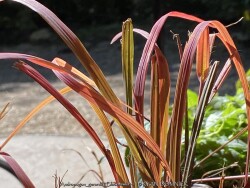

Big Bluestem (Andropogon gerardii 'Blackhawks') is easily grown in average, dry to medium, well-drained soils in full sun. It is tolerant of a wide range of soils and growing conditions but tends to flop in rich moist soils. This ornamantal grass is a tall, Kansas native, perennial, warm season grass that dominates much of the tall grass prairie extending into the Flint Hills. In fact, Big bluestem, Indiangrass, Little bluestem, and Switchgrass comprise 75% of the species in this ecosystem. It may be grown as an ornamental grass because of its attractive foliage which changes color seasonally along with its good architectural height and its interesting flower/seed heads. Andropogon gerardii 'Blackhawks' is primarily distinguished from the species by its slightly shorter height, deeper green summer foliage and blackish-purple fall color. An excellent garden performer with a clumping form and upright habit. Leaves emerge deep green with red highlights in spring, remain green through much of the summer, change to purplish-red to purple by late summer and finally turn a vivid scarlet red after first fall frost. Burgundy purple flowers bloom in August. Plants typically grow to 4-5' tall.
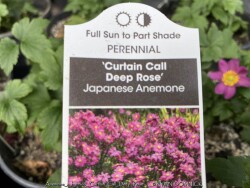

***Description for this perennial available with future update!***
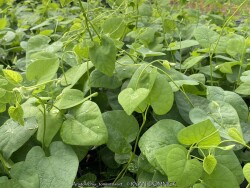

Dutchman's Pipe / Woolly Pipevine (Aristolochia tomentosa) is one of the most rapidly growing vines in out library capable of growing 15-30' in one summer! Native to eastern North America including Missouri, it typically occurs along moist woods and along streams. It can fill a large trellis or arbor with bright green foliage up to 12" across creating the most dense shade of any vine. It needs typical garden soil and regular moisture and is intolerant of drought. In Eastern Kansas, typically our 40 inches of rainfall is close to sufficient without much extra water if planted in good soils. The flowers are 1-2" across but are usually not noticed but is absolutely gorgeous with foliage alone.


Low Scape Snowfire Aronia (Aronia melanocarpa 'Low Scape Snowfire') compact mound shaped deciduous shrub that typically grows 3-5' tall. It is native to low woods, swamps, bogs and moist thickets native from the Midwest to Canada. This 3-season shrub had appeal from spring to late fall starting with numerous white flowers, then deep green summer foliage followed by brilliant red fall color and a few blackberries. Plant in small groups or mass plantings in small gardens. Ability to withstand wet conditions makes it suitable for growing on the margins of ponds, streams, or rain gardens. Despite 'Low Scape Snowfire' being touted as "drought tolerant", in the southern part of their range (Kansas), this chokeberry will decline in dry clay or alkaline soils. Watch out for deer and rabbits can devour young plants (protect with chicken wire if needed) but established plantings can generally outgrow browsing. The common name of chokeberry is in reference to the tart and bitter taste of the fruits which are edible but so astringent as to cause choking in most of those who try: no it's not poison!. Fruits are renowned for its antioxidant rich berries and high nutritional value and sometimes used to make tasty jams and jellies if enough sugar is added. Included in our "edibles" database but depends on how hungry you are! However, 'Low Scape Snowfire' sets a heavy crop for fruit production but rather as a compact landscape 3-season shrub tolerant of wet soils. All Proven Winners® plants are legally propagated, healthy and vigorous, true to name, and tagged with color pictures and growing information.
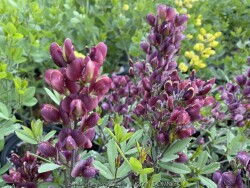

The False Indigo species (Baptisia) features beautiful compact bluish green leaves arranged in groups of three. Like many members in the legume family, they are nitrogen fixing plants which means they produce their own nitrogen in the soil through a symbiotic relationship with bacteria. The flowers bloom above the foliage normally in April and May. Common baptisia flower colors include white, purple, lavender, yellow, and pink as well as uncommon colors ranging from deep purple to maroon and even coppery orange. Considered a great North American native three season plant, the foliage always emerges very attractive followed by flowers that do not need deadheading. Foliage generally lasts pretty nice through hot summers and into fall turning black with first freeze. Seed pods also turn charcoal black when ripe and have considerable ornamental interest and useful in dried flower arrangements. At some point in the fall, it can be cut down early for a clean look or left for winter interest. Baptisia generally do well in droughty clay soils in full to part sun. There is only one pest that may create problems called the Genista Broom Moth. It may occur in Kansas when weather conditions are consistently dry and over 95 degrees F. It is treatable if you act fast but if not, it only destroys the foliage late in the season and does not kill the plant. Baptisia has several enormous spreading taproots which store water and energy and can make transplanting difficult. Plantings look good as specimen or in small groups; and it's ok even preferable if they grow together and touch other plants. That helps eliminate available sunlight and discourages weeds. It is hard to picture a native plant garden or any perennial garden without Baptisia. Considered a once "it's there, it's always there" plant. >>>>>Baptisia 'Burgundy Blast' features dark wine purple flowers are produced over very dark blue-green foliage. When it is in bloom, it is a stunning display of color. This extremely long-lived perennial could be used instead of a shrub in landscape settings, with minimal care required to thrive year after year.
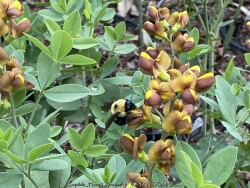

The False Indigo species (Baptisia) features beautiful compact bluish green leaves arranged in groups of three. Like many members in the legume family, they are nitrogen fixing plants which means they produce their own nitrogen in the soil through a symbiotic relationship with bacteria. The flowers bloom above the foliage normally in April and May. Common baptisia flower colors include white, purple, lavender, yellow, and pink as well as uncommon colors ranging from deep purple to maroon and even coppery orange. Considered a great North American native three season plant, the foliage always emerges very attractive followed by flowers that do not need deadheading. Foliage generally lasts pretty nice through hot summers and into fall turning black with first freeze. Seed pods also turn charcoal black when ripe and have considerable ornamental interest and useful in dried flower arrangements. At some point in the fall, it can be cut down early for a clean look or left for winter interest. Baptisia generally do well in droughty clay soils in full to part sun. There is only one pest that may create problems called the Genista Broom Moth. It may occur in Kansas when weather conditions are consistently dry and over 95 degrees F. It is treatable if you act fast but if not, it only destroys the foliage late in the season and does not kill the plant. Baptisia has several enormous spreading taproots which store water and energy and can make transplanting difficult. Plantings look good as specimen or in small groups; and it's ok even preferable if they grow together and touch other plants. That helps eliminate available sunlight and discourages weeds. It is hard to picture a native plant garden or any perennial garden without Baptisia. Considered a once "it's there, it's always there" long lived plant. Baptisia 'Honey Roasted' features long 10" spikes of dark mahogany flowers have bright yellow keels, producing a wonderful bicolor effect. The bushy habit is jam-packed with flowers when it is in bloom early in the growing season. Flowers lighten to yellow as the flowers mature. This extremely long-lived perennial could be used instead of a shrub in landscape settings, with minimal care required to thrive year after year.
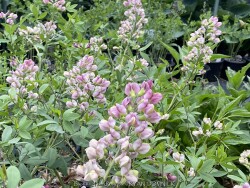

The False Indigo species (Baptisia) features beautiful compact bluish green leaves arranged in groups of three. Like many members in the legume family, they are nitrogen fixing plants which means they produce their own nitrogen in the soil through a symbiotic relationship with bacteria. The flowers bloom above the foliage normally in April and May. Common baptisia flower colors include white, purple, lavender, yellow, and pink as well as uncommon colors ranging from deep purple to maroon and even coppery orange. Considered a great North American native three season plant, the foliage always emerges very attractive followed by flowers that do not need deadheading. Foliage generally lasts pretty nice through hot summers and into fall turning black with first freeze. Seed pods also turn charcoal black when ripe and have considerable ornamental interest and useful in dried flower arrangements. At some point in the fall, it can be cut down early for a clean look or left for winter interest. Baptisia generally do well in droughty clay soils in full to part sun. There is only one pest that may create problems called the Genista Broom Moth. It may occur in Kansas when weather conditions are consistently dry and over 95 degrees F. It is treatable if you act fast but if not, it only destroys the foliage late in the season and does not kill the plant. Baptisia has several enormous spreading taproots which store water and energy and can make transplanting difficult. Plantings look good as specimen or in small groups; and it's ok even preferable if they grow together and touch other plants. That helps eliminate available sunlight and discourages weeds. It is hard to picture a native plant garden or any perennial garden without Baptisia. Considered a once "it's there, it's always there" long lived plant. Baptisia 'Plum Rosy' is an excellent vigorous pink and white flowered selection; quite a color break-thru for Baptisia! Pink blossoms age to white creating a bi-colored effect in late spring on bright green foliage. This full-size but dense habit can work like a shrub in any garden. This extremely long-lived perennial could be used instead of a shrub in landscape settings, with minimal care required to thrive year after year. This plant was introduced from Walters Gardens, Inc.


The False Indigo species (Baptisia) features beautiful compact bluish green leaves arranged in groups of three. Like many members in the legume family, they are nitrogen fixing plants which means they produce their own nitrogen in the soil through a symbiotic relationship with bacteria. The flowers bloom above the foliage normally in April and May. Common baptisia flower colors include white, purple, lavender, yellow, and pink as well as uncommon colors ranging from deep purple to maroon and even coppery orange. Considered a great North American native three season plant, the foliage always emerges very attractive followed by flowers that do not need deadheading. Foliage generally lasts pretty nice through hot summers and into fall turning black with first freeze. Seed pods also turn charcoal black when ripe and have considerable ornamental interest and useful in dried flower arrangements. At some point in the fall, it can be cut down early for a clean look or left for winter interest. Baptisia generally do well in droughty clay soils in full to part sun. There is only one pest that may create problems called the Genista Broom Moth. It may occur in Kansas when weather conditions are consistently dry and over 95 degrees F. It is treatable if you act fast but if not, it only destroys the foliage late in the season and does not kill the plant. Baptisia has several enormous spreading taproots which store water and energy and can make transplanting difficult. Plantings look good as specimen or in small groups; and it's ok even preferable if they grow together and touch other plants. That helps eliminate available sunlight and discourages weeds. It is hard to picture a native plant garden or any perennial garden without Baptisia. Considered a once "it's there, it's always there" plant. According to Walters Gardens, Baptisia 'Violet Dusk' features "lavender violet flowers with cream keels makes this a stunning display for the early season garden. Its claim to fame is its unique vase-like habit. Although this plant is 3' wide, the base of the plant takes up a relatively small footprint, leaving space to under plant with other perennials. In comparison to other Baptisia in our trials, 'Violet Dusk' is relatively late to bloom." This extremely long-lived perennial could be used instead of a shrub in landscape settings, with minimal care required to thrive year after year.


***Description for this perennial available with future update!***


Crossvine (Bignonia capreolata) is a highly ornamented evergreen vine native to the southeast west to Oklahoma and Texas. Fantastic blooms completely cover the plant and occur on old wood in the late spring for about 3-5 weeks then sporadically during the summer. Flowers are trumpet-shaped, orange and red with yellow throats. Although in the same family as trumpet vine (campus radicans), crossvine is not invasive. Plant crossvine on fences or pergolas where you want good coverage but not anything sprawling too far away from the structure needing pruning. Considered to be one of the lowest maintenance of all vines. Crossvine prefer for part to full sun on in medium to rich soils and are able to tolerate drought and brief flooding once established. There are no serious pests or diseases to worry about. Crossvine has thrived in our Lawrence Kansas zone 6a display garden for over 15 years enduring a few occasions of -10° or colder winters. Winter foliage turns purple and remains evergreen till about -10. We have seen -18° without any dieback on the vine other than the loss of foliage that year. This great vine has it all, beautiful flowers, evergreen foliage, and constrained growth habit! Dressed To Thrill Crossvine (Bignonia capreolata 'Dressed To Thrill') is colorful, extremely floriferous, and amazingly adaptable! his selection of our North American native crossvine transforms fences, walls, and trellises into a wall of flowers, climbing structures by tendrils. Orange-red trumpet-shaped flowers with bright yellow eyes enliven landscapes from spring through summer and provide a welcome food source for hummingbirds. Native from Ohio down to Texas, this semi-evergreen vine is adaptable to most any soil and exhibits excellent heat and drought tolerance.
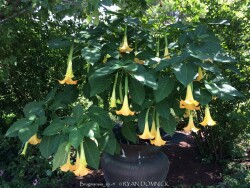

Brugmansia is a genus of seven species of flowering plants in the nightshade family Solanaceae from South America. It is typically grown in warmer zones as a shrub or tree but is extinct from the wild (only known in cultivation). Along with other tropicals and succulents in Kansas, Angel Trumpet Flower is usually grown as summer patio plant with amazing foot-long hanging flowers and sweet aroma. Water regularly and place in full sun or part shade. Protect from temperatures below 32 degrees F and move into a cold garage or basement over the winter with minimal watering. Do not allow the pot with rootball to freeze solid or go below 28 degrees for more than a few hours. Allow to go dormant as needed with little care, just cut off dead foliage/twigs and place back out in April or May with a time-release fertilizer. You may also propagate this plant easily by cutting off dormant twigs/branches and stuffing them into the ground. Notice that I didn't say rooting hormone or even being careful was necessary! Landscapers also plant these as an annual in the ground for an enormous tropical effect with fragrant flowers and growth reaching 5-8' in one season from a 1gal container! It is possible to overwinter Brugmansia in the ground in Kansas as a woody perennial. In our trial gardens in Lawrence, KS (zone 6a), a one year established specimen planted in our annual bed was mulched 12-18" thick with leaf mulch survived -10 degrees F. The dieback was deep into the ground but somehow came back from a piece of deep root. The leaf mulch was also well rotted and formed somewhat of an ice barrier insulating effect. Brugmansia species are amongst the most toxic of ornamental plants so do not eat and part of this plant! Flowers come in Orange, Red, Pink, and White.


With its glossy burgundy-red foliage, Red Zeppelin sweetshrub (Calycanthus floridus var. purpureus) will rock your world! The color of the foliage lasts all season and is accompanied by lightly fragrant orange-red flowers in late spring and early summer. Not only is it adaptable and easy to grow in the landscape, but our many years of trialing indicate it’s easy to grow in production, too. This selection of our North American native species was developed by the folks at Pleasant Run Nursery. Prune after flowering to maintain shape. Calycanthus perform amazingly well in eastern Kansas landscapes. It is great along a woodland edge or in morning sun, or in full sun for best foliage color show. It tolerates a wide variety of soil types including clay but needs prefers well-drained soil high in organic matter. Adaptable to mild drought and heat but greatly improved with rich, moisture-retentive soils. Typically, our 40 inches of rainfall per year in Eastern Kansas is sufficient. Summer foliage is virtually pest-free. All Proven Winners® plants are legally propagated, healthy and vigorous, true to name, and tagged with color pictures and growing information.


Jessamine / Hardy Cestrums are relatively new and upcomming plant. Our mix of species were purchased from Bustani Plant Farm in Stillwater, OK. Mostly listed as hardy to zone 7, you can easily push this into zone 6 with a layer of thick winter mulch. Mix of the following species proven hardy in Lawrence, KS: Cestrum aurantiacum, Cestrum ‘Greystone Gold’, Cestrum ‘Orange Peel’. Many visitors in the display garden are amazed by the uniqueness and beauty. It really resembles a "yellow flowering lilac" with flowers and foliage. Similar to a Crapemyrtle, These Cestrum varieties are hardy outside when grown as a perennial and cut back hard each year. During the growing season, fertilize, water regularly, and plant in full sun. Plant a little deep at first; about 2-3" deep with 4-6" of mulch. In our trial gardens in Lawrence, KS (zone 6a), the following varieties survived after being mulched 6-12" with leaf mulch. During the arctic blast of January, 2024, lows down to -11 degrees F on Jan 10th, 2024 were recorded. The longevity of this cold blast was also impressive: 4 days on a row with single digit highs including 1 day with a negative high(-2F), 4 nights of lows in negatives(-8For lower), and 48 straight hours of 0 degrees F and mostly lower.


Jessamine / Hardy Cestrums are relatively new and upcomming plant. Our mix of species were purchased from Bustani Plant Farm in Stillwater, OK. Mostly listed as hardy to zone 7, you can easily push this into zone 6 with a layer of thick winter mulch. Mix of the following species proven hardy in Lawrence, KS: Cestrum aurantiacum, Cestrum ‘Greystone Gold’, Cestrum ‘Orange Peel’. Many visitors in the display garden are amazed by the uniqueness and beauty. It really resembles a "yellow flowering lilac" with flowers and foliage. Similar to a Crapemyrtle, These Cestrum varieties are hardy outside when grown as a perennial and cut back hard each year. During the growing season, fertilize, water regularly, and plant in full sun. Plant a little deep at first; about 2-3" deep with 4-6" of mulch. In our trial gardens in Lawrence, KS (zone 6a), the following varieties survived after being mulched 6-12" with leaf mulch. During the arctic blast of January, 2024, lows down to -11 degrees F on Jan 10th, 2024 were recorded. The longevity of this cold blast was also impressive: 4 days on a row with single digit highs including 1 day with a negative high(-2F), 4 nights of lows in negatives(-8For lower), and 48 straight hours of 0 degrees F and mostly lower.


Jessamine / Hardy Cestrums are relatively new and upcomming plant. Our mix of species were purchased from Bustani Plant Farm in Stillwater, OK. Mostly listed as hardy to zone 7, you can easily push this into zone 6 with a layer of thick winter mulch. Mix of the following species proven hardy in Lawrence, KS: Cestrum aurantiacum, Cestrum ‘Greystone Gold’, Cestrum ‘Orange Peel’. Many visitors in the display garden are amazed by the uniqueness and beauty. It really resembles a "yellow flowering lilac" with flowers and foliage. Similar to a Crapemyrtle, These Cestrum varieties are hardy outside when grown as a perennial and cut back hard each year. During the growing season, fertilize, water regularly, and plant in full sun. Plant a little deep at first; about 2-3" deep with 4-6" of mulch. In our trial gardens in Lawrence, KS (zone 6a), the following varieties survived after being mulched 6-12" with leaf mulch. During the arctic blast of January, 2024, lows down to -11 degrees F on Jan 10th, 2024 were recorded. The longevity of this cold blast was also impressive: 4 days on a row with single digit highs including 1 day with a negative high(-2F), 4 nights of lows in negatives(-8For lower), and 48 straight hours of 0 degrees F and mostly lower.
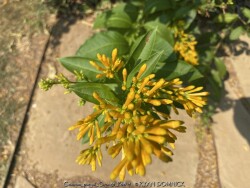

Jessamine / Hardy Cestrums are relatively new and upcomming plant. Brighten up summertime with Juiced® Orange jessamine. This compact hybrid jessamine has deliciously colorful blooms and bright glossy foliage. These citrus-hued, tubular flowers attract both butterflies and hummingbirds. Blooming from spring to frost, this tropical evergreen has dark, glossy foliage and a superior, bushy habit along with easy care: no need to trim to keep the blooms coming! In colder climates, it can be grown as a patio plant and overwintered in a sunroom. This is a fun and colorful South American native that offers uniqueness and novelty that everyone will crave. Mostly listed as hardy to zone 7, you can easily push this into zone 6 with a layer of thick winter mulch. Many visitors in the display garden are amazed by the uniqueness and beauty. It really resembles a "yellow flowering lilac" with flowers and foliage. Similar to a Crapemyrtle, Cestrums are hardy outside when grown as a perennial and cut back hard each year. It will re-grow from the roots and still flower on new wood by mid-summer. During the growing season, fertilize, water regularly, and plant in full sun. Plant a little deep at first; about 2-3" deep with 4-6" of mulch. In our trial gardens in Lawrence, KS (zone 6a), the following varieties survived after being mulched 6-12" with leaf mulch. During the arctic blast of January, 2024, lows down to -11 degrees F on Jan 10th, 2024 were recorded. The longevity of this cold blast was also impressive: 4 days on a row with single digit highs including 1 day with a negative high(-2F), 4 nights of lows in negatives(-8For lower), and 48 straight hours of 0 degrees F and mostly lower. PROVEN WINNERS variety.


Jessamine / Hardy Cestrums are relatively new and upcomming plant. Our mix of species were purchased from Bustani Plant Farm in Stillwater, OK. Mostly listed as hardy to zone 7, you can easily push this into zone 6 with a layer of thick winter mulch. Mix of the following species proven hardy in Lawrence, KS: Cestrum aurantiacum, Cestrum ‘Greystone Gold’, Cestrum ‘Orange Peel’. Many visitors in the display garden are amazed by the uniqueness and beauty. It really resembles a "yellow flowering lilac" with flowers and foliage. Similar to a Crapemyrtle, These Cestrum varieties are hardy outside when grown as a perennial and cut back hard each year. During the growing season, fertilize, water regularly, and plant in full sun. Plant a little deep at first; about 2-3" deep with 4-6" of mulch. In our trial gardens in Lawrence, KS (zone 6a), the following varieties survived after being mulched 6-12" with leaf mulch. During the arctic blast of January, 2024, lows down to -11 degrees F on Jan 10th, 2024 were recorded. The longevity of this cold blast was also impressive: 4 days on a row with single digit highs including 1 day with a negative high(-2F), 4 nights of lows in negatives(-8For lower), and 48 straight hours of 0 degrees F and mostly lower.


Double Take® Pink Quince (Chaenomeles 'Double Take Pink') features huge flowers on a thornless plant! You'll do a double take when you see this quince that looks like a camellia. Double Take Pink puts on a spectacular early season display of pink blooms. The large, double flowers are excellent in cut flower arrangements. Bright spring flowers are only the beginning of the Double Take quince's appeal: they're also thornless, and do not produce fruit. Extremely drought tolerant once established, these early spring charmers are excellent landscape plants and real survivalists in tough climates. Developed by Dr. Tom Ranney and his team at the Mountain Horticultural Crops Research & Extension Center in beautiful North Carolina, they are sure to brighten spring landscapes across the United States.Uses Notes: Intense early spring color is excellent for mixed borders and cutting gardens. Also good for hedging and mass plantings. Maintenance Notes: Trim to shape after flowering. Apply a controlled release fertilizer in spring. Formerly sold as Double Take 'Pink Storm' quince. In Eastern Kansas, this cultivar performs WELL with just about everything nature has to challenge it! Heat and drought are tolerated reasonably well but with some foliage decline by late summer and no fall color. This is made up for by the extremely reliable blooming season that fills up the month of April when many other plants are not in full swing yet. Cold tolerance or flower bud loss is no problem in our zone 6. No serious disease or pest problems. All Proven Winners® plants are legally propagated, healthy and vigorous, true to name, and tagged with color pictures and growing information.


***Description for this plant available with future update!***


***Description for this hardy tropical available with future update!***>>>>>Desert Willow is a small open irregularly branched tree or large shrub with bright green narrow leaves (but not related to true willows) It features gorgeous pink, white and magenta snapdragon-like flowers with yellow throats. Blooming season is immensely long beginning in June continuing all summer until frost. Desert Willow grows in all soil types here in Kansas but prefers rich silty loam. It will not grow in excessively wet anaerobic soils though. Absolute full sun is needed for best growth to produce flowers and avoid spindlyness. In the landscape, Desert Willow can be used as a specimen shrub or small tree. It handles hot west for south locations very well. It's native range covers most of the Southwest and western Texas along streams and riparian areas. Being surprisingly cold hardy here, Several Desert Willow cultivars can be found at the Denver Botanic Gardens in Denver CO (zone 5b) and at the Dyck Arboretum in Hesston, Kansas (zone 6b). Bubba Desert Willow (Chilopsis linearis 'Bubba') has been thriving in our display garden and other Lawrence, KS locations for over 15 years and has endured temperatures as low as a -18. During the most severe winters, winter kills it down to the ground. However, just like Crapemyrtle or Butterfly Bush, Desert Willow blooms on new wood and at a young age with blooms even occurring on 3 foot tall nursery plants. Water sprout regrowth from established landscape plants is rapid with heights reaching 5-6'. These blooms are more numerous and larger than normal, especially with a handful of time-release fertilized applied in the early spring.
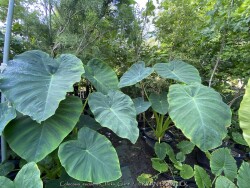

***Description for this plant available with future update!***>>>>> Plant Delights Nursery says "Colocasia esculenta 'Jack's Giant' is a plant that we received from Jack de Vroomen of Marlboro Bulb Company, who brought this to us from Costa Rica. The tuber was much larger and shaped differently from other Colocasia esculenta forms we had grown. In our garden, the plants easily reached 7' tall, even in a very dry section, with medium green leaves similar to typical Colocasia esculenta. We are pretty sure it is a triploid form, which should increase winter hardiness. (Hardiness Zone 7b-10)"


Crinums are tough, long-lived perennial bulbs with strappy leaves and fragrant, funnel-shaped flowers. In areas where the bulbs are hardy, (zones 5/6-10) these plants can reach as much as 4 feet across and bloom all summer. Crinums can live for 200-300 years in the South often found growing in cemeteries and abandoned home sites with little or no attention. The plants are native to southeast Asia often in areas with a summer monsoon and dry winter. They can also be grown as flowering summer patio plants. If growing as a potted plant and trying to overwinter, allowing the foliage to frost is ok, it will not kill the root system. However, do not allow the pot with rootball to freeze solid or go below 20 degrees for more than a few hours; move into a cold garage or basement over the winter with no watering. Cut back and allow to go dormant and place entire pot back out in April or May with a time-release fertilizer. During the growing season, fertilize, water regularly, and place in full sun. You may also plant these in the ground for an enormous tropical effect! It is easy to overwinter these in the ground in Kansas with mulch or no mulch! The trick is to plant them deep: an extra 4-6" deeper than grade or with neck of bulb completely buried. Crinums are extremely adaptable thriving in either in dry or in boggy soils. Crinums are tough, low maintenance bulbs which make them perfect for rain gardens, and although drought-tolerant, crinums bloom more if well-watered. This plant can also grow in standing water or as a potted plant in water gardens. Unlike southern climates, crinums in Kansas need full sun to grow and flower in our shorter growing season. Crinum are more cold hardy than most authorities publish; easily pushing into zone 5 for some varieties. In our trial gardens in Lawrence, KS (zone 6a), the following varieties survived after being mulched 6-12" with leaf mulch to -17 degrees F. (Crinum 'Infusion', Crinum tweedianum, Crinum 'Super Ellen', Crinum x powellii, Crinum 'White Prince') During the arctic blast of February, 2021, lows down to -17 degrees F on Feb 16th, 2021 were recorded. The longevity of this cold blast was also impressive: 10 days on a row with highs of 10-15 degrees F or lower, 8 nights of lows in the single digits and negatives, and 36 straight hours of 0 degrees F and mostly lower. No crinums were lost or harmed during this event!
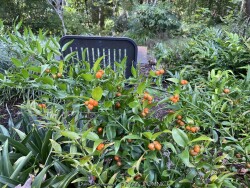

***Description for this hardy tropical available with future update!***
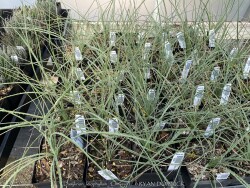

***Description for this plant available with future update!*** With extremely well drained soils and proper siting, this cactus seems to take our excess rainfall in Eastern Kansas. These and other hardy barrel cacti are perfect for a dry mounded xeriscape gardens under south facing roof overhangs where it gets no winter moisture. We are also testing this outside in our Lawrence, KS (zone 6a) crevice garden among other cold-hardy cacti, succulents, and yucca! Watch for future updates-Jan-2025
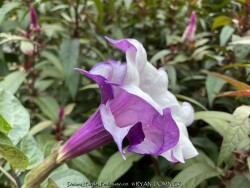

***Description for this plant available with future update!***


Looking for an adaptable native plant that's drought-tolerant, deer-resistant and colorful? This is it! Diervilla just got a lot more colorful: this tough, easy-growing shrub (Diervilla rivularis 'Kodiak Black') is a standout with its dark burgundy-black foliage. The color is especially intense in spring and autumn. The bright yellow flowers add contrast in early summer. This is a durable native that thrives in sun or shade, and is a very useful landscape plant. Now improved! Kodiak Jet Black™ diervilla is the world’s first black Diervilla that stays jet black all season long. While other diervilla tend to fade in summer, this shrub maintains its deep, striking black foliage, which creates quite the contrast with its bright yellow summer flowers. Top three reasons to grow Kodiak® Jet Black Diervilla:1.One of the best shade-tolerant shrubs (though color is more intense in sun or part shade) 2.Never without clusters of yellow flowers during the summer 3.Dramatic black-purple foliage all season with vivid red tones in autumn. Uses Notes:Naturalizing; mass plantings. Maintenance Notes: Adaptable to most soils, including dry ones. Trim in spring and apply a controlled-release fertilizer. Though it is sometimes called "bush honeysuckle," Diervilla is not invasive. In Eastern Kansas, this cultivar performs WELL with just about everything nature has to challenge it! Heat and drought are tolerated if in shade or morning sun. Cold tolerance is no problem. No disease or pest problems. Great plant for dry-shade. Native to North America. All Proven Winners® plants are legally propagated, healthy and vigorous, true to name, and tagged with color pictures and growing information.


Kodiak® Red 2.0 Diervilla (Diervilla rivularis 'Kodiak Red') provides rugged beauty for the toughest spots in your landscape. Kodiak® Red diervilla is a native flowering shrub that looks great while shrugging off shade and problem soils. New growth emerges in spring with a deep burgundy tone, and turns vivid red in fall. During summer, leaves have a red edge and clusters of small yellow flowers appear all season. It's a simple but beautiful way to add low-maintenance color to parts of your yard that have been difficult to landscape. Kodiak Red 2.0 is sure to delight you with darker, longer lasting color. The blush on the new growth throughout the growing season is more reliable and the red of the fall color is intense. Top reasons to grow Kodiak Red diervilla: 1.One of the toughest landscape plants around! 2.Foliage emerges red and turns bright red in fall. 3.Yellow flowers all summer long. Diervilla needs very little care - if you'd like to prune it, do so in early spring. It does not require regular pruning, but if it starts to get a little sparse as it matures, cut it back to the ground in early spring for a fresh start. Uses Notes: The long, straight stems and neat foliage of diervilla makes it an excellent filler for cut flower arrangements. Maintenance Notes: Diervilla needs very little care - if you'd like to prune it, do so in early spring. It does not require regular pruning, but if it starts to get a little sparse as it matures, cut it back to the ground in early spring for a fresh start. Diervilla is sometimes called "bush honeysuckle," and though it is related to honeysuckle, diervilla flowers are not fragrant. However, more importantly, diervilla is NOT invasive, so it's a safe choice for planting anywhere. In Eastern Kansas, this cultivar performs WELL with just about everything nature has to challenge it! Heat and drought are tolerated if in shade or morning sun. Cold tolerance is no problem. No disease or pest problems. Great plant for dry-shade. Native to North America. All Proven Winners® plants are legally propagated, healthy and vigorous, true to name, and tagged with color pictures and growing information.
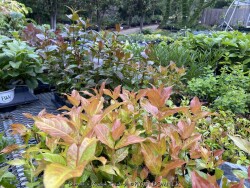

Looking for a durable native plant that will thrive in sun or shade, and is drought-tolerant? Deer-resistant, too? You've got it! This shrub (Diervilla x 'Kodiak Fresh') gives a new look to Diervilla with its bright lime-yellow foliage in summertime, always accompanied by bright yellow flowers. Like the other members of the Kodiak series, it lights up the fall landscape, making it an eco-friendly alternative to burning bush. A durable native plant that thrives in sun or shade, it is drought-tolerant, deer-resistant, and can even grow in dry shade. This is an excellent landscape plant that will succeed in even challenging sites. Top three reasons to grow Kodiak® Fresh diervilla: 1.Tolerant of dry shade (though color is best with at least some sun) 2.Never without yellow flower clusters in the summer. 3.Orangey-red new growth, persistent lime coloring, and glowing orange fall foliage. Uses Notes: Naturalizing; mass plantings. Maintenance Notes: Adaptable to most soils, including dry ones. Trim in spring and apply a controlled-release fertilizer. Though it is sometimes called "bush honeysuckle," Diervilla is not invasive like certain honeysuckles are. In Eastern Kansas, this cultivar performs WELL with just about everything nature has to challenge it! Heat and drought are tolerated if in shade or morning sun. Cold tolerance is no problem. No disease or pest problems. Great plant for dry-shade. Native to North America. All Proven Winners® plants are legally propagated, healthy and vigorous, true to name, and tagged with color pictures and growing information.
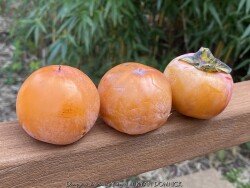

Meader Persimmon Tree (Fruiting Cultivar), is also known as Diospyros virginiana 'Meader'. >>>>> According to Starks Bros "A sweet native of Indiana. This fast-growing variety is pest- and disease-resistant. When fruit is soft and completely mature, it features a sweet, apricot-like flavor. Cold-hardy and heat-tolerant. Tree reaches 35-50' tall. Ripens in early September. Grafted. Self-pollinating. In Fall, enjoy harvesting large, orange, flavorful fruit with no black spots. Cross-pollination by a different variety is key to its growing and bearing success. Almost all American persimmon trees require a pollinator to bear fruit except 'Meader' and 'Yates'. Persimmons ripen in October to November with bright orange fruit. The fruit softens and sweetens once they experience frost. In many cases, you may still want to plant pollinating partners to increase the size of your crops, but with self-pollinating varieties doing so is optional. You'll get fruit with only one plant."


***Description for this perennial available with future update!***>>>>> Echinacea purpurea is an herbaceous perennial native to parts of eastern and midwestern United States most common in Missouri and Arkansas. Its habitats include dry open woods, prairies and barrens. Echinacea are native to North America, featuring sunflower-like flowers with a dark center and colorful petals. Colors on native plants include purple, magenta, white, yellow. Intensive breeding efforts to fish out recessive genes have brought bright orange and red into the picture. Flowers occur in early to mid summer often continuing into fall especially if dead-headed. Its individual flowers (florets) within the flower head are two-toned, having both male and female organs in each flower. (hermaphroditic) Bees and butterflies including the monarch are common pollinators. The dead flowers are attractive to some for winter interest but for those wanting a tidy your garden, they can be trimmed early. Leaving some dried seed heads will be beneficial for wildlife and provide winter food for finches and other birds. Best growth generally occurs in full to part sun with well drained soils with low to average moisture. In Eastern Kansas, typically our 40 inches of rainfall is sufficient without extra water. Coneflower can also handle short one to two day flooding events and are sometimes used along the higher perimeter of rain gardens to bring in pollinators. Coneflower mixes well with many other types of plants ranging from other native plants to evergreens to hardy tropicals. Rabbits can be a problem young immature plants. A popular method of control is covering the plant with an upside down bowl-shaped chicken wire cage for the first year to allow basil foliage to establish well. You can quickly make these yourself with a low cost roll of chicken wire. Mature plants especially in groups with other mature landscaping generally do not have rabbit problems. Flowers are also popular in the florist industry as cut flowers or in the cottage garden. The genus echinacea has undergone intense breeding with the introduction of hundreds of new cultivars in the last 10 years.
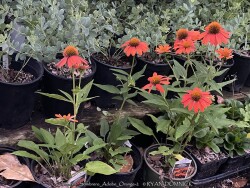

***Description for this perennial available with future update!***>>>>> Echinacea purpurea is an herbaceous perennial native to parts of eastern and midwestern United States most common in Missouri and Arkansas. Its habitats include dry open woods, prairies and barrens. Echinacea are native to North America, featuring sunflower-like flowers with a dark center and colorful petals. Colors on native plants include purple, magenta, white, yellow. Intensive breeding efforts to fish out recessive genes have brought bright orange and red into the picture. Flowers occur in early to mid summer often continuing into fall especially if dead-headed. Its individual flowers (florets) within the flower head are two-toned, having both male and female organs in each flower. (hermaphroditic) Bees and butterflies including the monarch are common pollinators. The dead flowers are attractive to some for winter interest but for those wanting a tidy your garden, they can be trimmed early. Leaving some dried seed heads will be beneficial for wildlife and provide winter food for finches and other birds. Best growth generally occurs in full to part sun with well drained soils with low to average moisture. In Eastern Kansas, typically our 40 inches of rainfall is sufficient without extra water. Coneflower can also handle short one to two day flooding events and are sometimes used along the higher perimeter of rain gardens to bring in pollinators. Coneflower mixes well with many other types of plants ranging from other native plants to evergreens to hardy tropicals. Rabbits can be a problem young immature plants. A popular method of control is covering the plant with an upside down bowl-shaped chicken wire cage for the first year to allow basil foliage to establish well. You can quickly make these yourself with a low cost roll of chicken wire. Mature plants especially in groups with other mature landscaping generally do not have rabbit problems. Flowers are also popular in the florist industry as cut flowers or in the cottage garden. The genus echinacea has undergone intense breeding with the introduction of hundreds of new cultivars in the last 10 years.
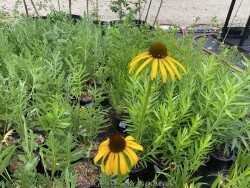

***Description for this perennial available with future update!***>>>>> Echinacea purpurea is an herbaceous perennial native to parts of eastern and midwestern United States most common in Missouri and Arkansas. Its habitats include dry open woods, prairies and barrens. Echinacea are native to North America, featuring sunflower-like flowers with a dark center and colorful petals. Colors on native plants include purple, magenta, white, yellow. Intensive breeding efforts to fish out recessive genes have brought bright orange and red into the picture. Flowers occur in early to mid summer often continuing into fall especially if dead-headed. Its individual flowers (florets) within the flower head are two-toned, having both male and female organs in each flower. (hermaphroditic) Bees and butterflies including the monarch are common pollinators. The dead flowers are attractive to some for winter interest but for those wanting a tidy your garden, they can be trimmed early. Leaving some dried seed heads will be beneficial for wildlife and provide winter food for finches and other birds. Best growth generally occurs in full to part sun with well drained soils with low to average moisture. In Eastern Kansas, typically our 40 inches of rainfall is sufficient without extra water. Coneflower can also handle short one to two day flooding events and are sometimes used along the higher perimeter of rain gardens to bring in pollinators. Coneflower mixes well with many other types of plants ranging from other native plants to evergreens to hardy tropicals. Rabbits can be a problem young immature plants. A popular method of control is covering the plant with an upside down bowl-shaped chicken wire cage for the first year to allow basil foliage to establish well. You can quickly make these yourself with a low cost roll of chicken wire. Mature plants especially in groups with other mature landscaping generally do not have rabbit problems. Flowers are also popular in the florist industry as cut flowers or in the cottage garden. The genus echinacea has undergone intense breeding with the introduction of hundreds of new cultivars in the last 10 years.


***Description for this perennial available with future update!***>>>>> Echinacea purpurea is an herbaceous perennial native to parts of eastern and midwestern United States most common in Missouri and Arkansas. Its habitats include dry open woods, prairies and barrens. Echinacea are native to North America, featuring sunflower-like flowers with a dark center and colorful petals. Colors on native plants include purple, magenta, white, yellow. Intensive breeding efforts to fish out recessive genes have brought bright orange and red into the picture. Flowers occur in early to mid summer often continuing into fall especially if dead-headed. Its individual flowers (florets) within the flower head are two-toned, having both male and female organs in each flower. (hermaphroditic) Bees and butterflies including the monarch are common pollinators. The dead flowers are attractive to some for winter interest but for those wanting a tidy your garden, they can be trimmed early. Leaving some dried seed heads will be beneficial for wildlife and provide winter food for finches and other birds. Best growth generally occurs in full to part sun with well drained soils with low to average moisture. In Eastern Kansas, typically our 40 inches of rainfall is sufficient without extra water. Coneflower can also handle short one to two day flooding events and are sometimes used along the higher perimeter of rain gardens to bring in pollinators. Coneflower mixes well with many other types of plants ranging from other native plants to evergreens to hardy tropicals. Rabbits can be a problem young immature plants. A popular method of control is covering the plant with an upside down bowl-shaped chicken wire cage for the first year to allow basil foliage to establish well. You can quickly make these yourself with a low cost roll of chicken wire. Mature plants especially in groups with other mature landscaping generally do not have rabbit problems. Flowers are also popular in the florist industry as cut flowers or in the cottage garden. The genus echinacea has undergone intense breeding with the introduction of hundreds of new cultivars in the last 10 years.
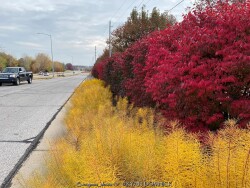

***Shrub descriptions available with future update!*** >>>>> Spring Meadow Nursery says "Better stem hardiness than typical dwarf burning bush. Fire Ball® burning bush is an improved selection of compact burning bush with tighter branching and superior hardiness. Other varieties of burning bush may experience die-back during harsh winters; Fire Ball® euonymus has experienced zero damage even in the coldest of Midwestern winters"
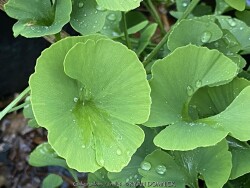

***Shrub descriptions available with future update!***>>>>>Troll Ginkgo Shrub, is also known as Ginkgo biloba 'Troll'. 'Troll' is a dwarf shrubby cultivar that matures over time to only 3' tall and as wide. It typically grows in a bushy mound, although it can be trained to grow as a small pyramidal tree. As with species plants, the fan-shaped leaves (biloba means two-lobed) are rich green to blue green during the growing season, but change to bright yellow in fall.
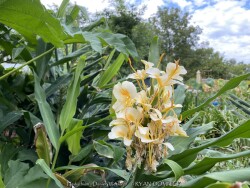

Hardy Ginger (Hedychium) are typically grown for their late summer flowers and vertical wide-leaf foliage. The plants are large tropical and subtropical herbaceous perennials with a rhizomatous rootstock native to areas with a summer monsoon and dry winter. They can be grown as flowering summer patio plants. If growing as a potted plant and trying to overwinter, allowing the foliage to frost is ok, it will not kill the root system. However, do not allow the pot with rootball to freeze solid or go below 20 degrees for more than a few hours; move into a cold garage or basement over the winter with no watering. Cut back and allow to go dormant and place entire pot back out in April or May with a time-release fertilizer. Another more labor intensive way to overwinter cannas is to remove them from the dirt, dust with fungicide, place in box with sawdust, and keep in the refrigerator. We consider this method old-fashioned and too much work but ok if you only want to save a few pieces. If digging from the ground, just save a big chunk with the dirt intact and place into a large pot in the garage. During the growing season, fertilize, water regularly, and place in full sun. You may also plant these in the ground for an enormous tropical effect! It is possible to overwinter these in the ground in Kansas by mulching 6-12" thick over deeply planted rhizomes. New growth may be slightly delayed but probably quick to regain full height. Native habitat for most hedychiums aligns well with our dry winters and warm humid summers. In our trial gardens in Lawrence, KS (zone 6a), we will be testing several varieties in 2022-2023. Famous plantsman, Tony Avent, owner of Plant Delights Nursery in Raleigh, North Carolina, advised us that hedychiums should survive fine here in the ground when mulched like cannas.
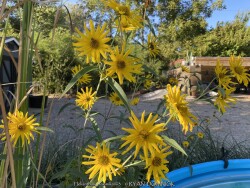

Maximilian's Sunflower is a very tall and showy wildflower native to the Great Plains in central North America and Canada. It has a distinctive fold down the mid-rib center of the narrow leaf. The leaf may be up to 12" long, slightly curved, and arranged in a whorl around the unbranching stems. In rich soils with average moisture, it reaches up to 10 feet tall and towers above surrounding vegetation when in bloom. In Eastern Kansas, typically our 40 inches of rainfall is sufficient without extra water. It is best suited for full sun and dry to medium soils to control height and to avoid floppiness. Like most other Sunflower species, Maximilian's Sunflower attracts a several different species of bees and butterflies. This species spreads by rhizomes and may spread too vigorously for most gardens, and therefore needs plenty of room. It is best used for naturalizing, roadway ditch plantings, buffer zones, or as as large isolated clumps. Cut or mow all foliage down in the winter, mowing around it during the growing season generally stops the yearly spread.